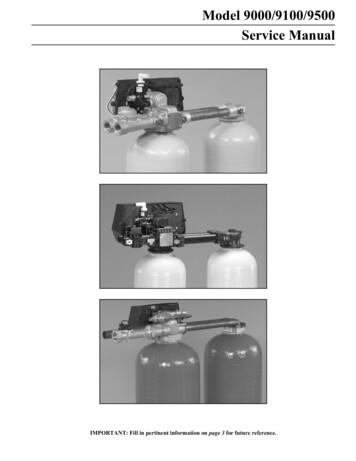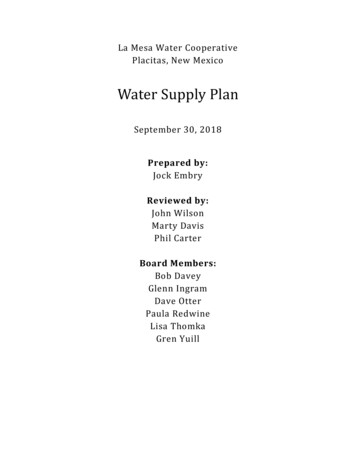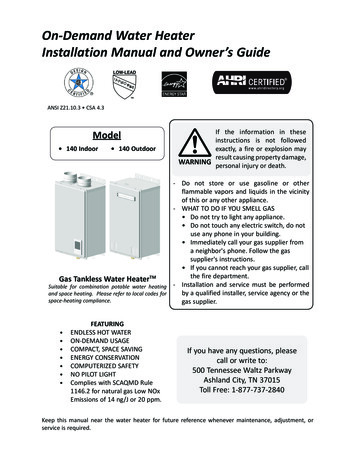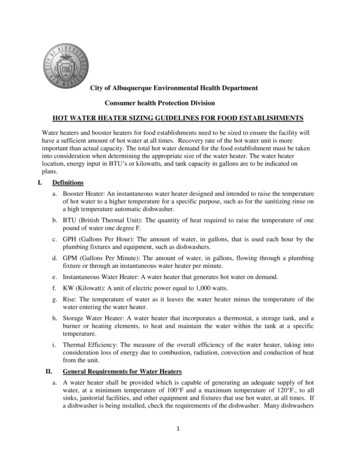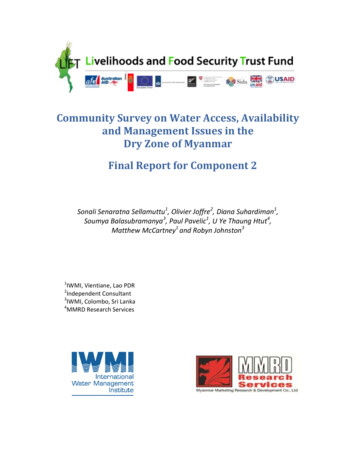
Transcription
Community Survey on Water Access, Availabilityand Management Issues in theDry Zone of MyanmarFinal Report for Component 2Sonali Senaratna Sellamuttu1, Olivier Joffre2, Diana Suhardiman1,Soumya Balasubramanya3, Paul Pavelic1, U Ye Thaung Htut4,Matthew McCartney1 and Robyn Johnston31IWMI, Vientiane, Lao PDRIndependent Consultant3IWMI, Colombo, Sri Lanka4MMRD Research Services2
CONTENTSList of Figures iiList of Tables iiSummary 11.Introduction 42.Methodology 52.12.22.3.2.43.Sampling framework 5Method and tools adopted in the community survey 11Institutional Analysis 13Implementation of the community survey, groundwater questionnaire and institutionalstudy 14Water Resources at the village level – an Overview 163.13.24.Diversity of water resources and uses at the village level 16Groundwater resources - trends 19Climatic Variations and Shocks 224.14.24.34.45.Major weather hazards in last 10 yearsDefinitions of weather hazards and type of impactFrequency of weather eventsWeather hazards and income portfolios22242526Water Access, Availability and Management in terms of Agriculture, Livestockand Domestic Use 305.1Agriculture 315.1.1.5.1.25.2Livestock 375.2.15.36.Irrigated Agriculture 32Opportunities and constraints of Groundwater Irrigation 33Type of livestock and water source and availability 37Domestic use 39Institutional Arrangements associated with Water Use and Management 446.16.26.36.47.8.Local institutions as the building blocks of ‘good governance’Local institutional arrangements: Case study descriptionCase study analysis: Institutional functioning and the role of collective actionWater Users Associations, policy trends in irrigation development, and potential entrypoints for institutional strengthening44454849Past and Current Interventions 51Potential Interventions 538.18.28.3Results by village type – access to irrigation 54Results by farmer type 54Results by village and farmer type 559.ConclusionsReferencesAnnex 1: Water Sources and Characteristics for each VillageAnnex 2: Past and Current Interventions captured through the Community Surveyi58606267
List of FiguresFigure 2.1.Figure 2.2.Figure 3.2.Figure 4.1.Figure 4.2.Figure 5.1.Figure 5.2.Vulnerability and opportunities of local livelihoods in relation to access and availabilityof water 5Villages in our sample for the community survey 10Average number of private well in village 19Frequency of weather hazard in rainfed (n 11), village with supplementary irrigation(n 7) and irrigated villages (n 5). One village with extreme value was removed from thesample. 26Income repartition during a good year for marginal and landless farmers in irrigated,rainfed and villages with supplementary irrigation 27Examples of cropping calendar in the Dry Zone 32Average volume of water collected by households in dry season and drought period 42List of TablesTable 2.1.Table 2.2.Table 2.3.Table 2.4.Table 3.1.Table 4.1.Table 4.2.Table 4.3.Table 4.4.Table 5.1.Table 5.2Table 5.3.Table 5.4.Table 5.5.Table 5.6.Table 5.7.Table 6.1.Table 8.1.Table 8.2.Townships selected for the community survey 7Sampling framework for the community survey and institutional study 8Village categories based on irrigated and rainfed 9Selection criteria and topics covered under the FGDs held for the Community Survey 12Different types of water sources per type of village 18Frequency of major weather hazard in the last 10 years 23Examples of rainfed villages illustrating how absolute income from rainfed agriculturechanges between a good year and year with a weather hazard (dry spell) 28Example of a rainfed village illustrating how absolute income from casual labor bothwithin the village and out-migration changes between a good year and year with aweather hazard (dry spell) 28Example of rainfed villages illustrating how absolute income from livestock changesbetween a good year and year with a weather hazard (dry spell) 29Irrigated crops type and source of irrigation 33Farming systems of the well-owner farmers 34Farmer-wise costs to setup groundwater infrastructure 35Frequency of presence of livestock and average number of animal per household inirrigated and rainfed villages 37Source of water, distance and period of drought for livestock in rainfed and irrigatedvillages 38Main source of drinking water in irrigated and rainfed villages (%) 40Average distance (in minutes) to domestic water source in rainfed village 40Overview of local institutional arrangements 48Potential intervention options discussed and voted on during community survey 53Preferences by farmer-type and access to irrigation 55ii
SummaryIn our community level survey, we employed a stratified approach to select 24 villages that coveredthe three regions - Mandalay, Magway and Sagaing in the Dry Zone of Myanmar. We endeavored togain a better understanding of the relationship, both direct and indirect between water relatedissues and local livelihood strategies, especially for the most vulnerable groups, i.e., the marginal andlandless that make up a large proportion, approximately 79.5%1 of the population in the Dry Zone.We ascertain at the village level, the availability of water for different uses and opportunities andconstraints to access and manage water as perceived by local people. In addition, we also examinedvarious institutional arrangements at village/community level in relation to farmers' farmingstrategies and water management practices as well as domestic water use.Our assessment was essentially qualitative in nature. For the purpose of our analysis we categorizevillages in our sample into: villages with irrigation all year around, villages with supplemental wetseason irrigation and rainfed villages (which do not have irrigation). We also identify three types offarmers: landed (those that own between 5-15 acres of farming land), marginal (those who own lessthan 5 acres and are not food secure for the entire year) and landless (farmers without farm land,who are not renting land for farming, and who are not food secure throughout the year).We obtained an overview of water resources at the village level. As expected, our findings revealedthat the sources of water, availability of water both in a temporal and spatial context, and access towater to utilize for different purposes varies across the villages in our sample. In general it appearsthat that in irrigated villages, the average number of water sources is greater than in rainfed villages.Water availability in surface water sources such as ponds and reservoirs vary a lot in a temporalcontext, from two months to perennial water bodies. Furthermore, there has been a rapid growth inthe exploitation of groundwater in the last ten years. Irrigated villages show the highest increaseover the last 10 years in groundwater use, with an increase in private motorized tube wells. Rainfedvillages appeared to have a limited number of wells in comparison, often citing water quality issues.Overall, access to groundwater can be constrained by a number of different factors such as: waterquality issues, as mentioned above, with non-drinkable groundwater (due to high salt content andother mineral contaminants); investment required for establishing tube wells in addition tomaintenance and costs linked with pumping in the case of motorized tube wells; andoverexploitation in areas where the local demand exceeds the natural supply. Our survey highlightedthat the total investment cost needed to establish groundwater irrigation is highly conditional uponthe local conditions and can vary by an order of magnitude. Therefore knowledge of thehydrogeological conditions is crucial to effective planning at the local level and to minimize poorinvestments.With regard to rainfall in the Dry Zone, it was interesting to note that the weather hazardsassociated with drought, dry spells and temporal variability of the monsoon, described during thecommunity survey, are in line with the key findings from Component 1 of our study which revealedthat there had been a significant reduction in rainfall amounts in June in recent years, combined1We calculate this figure based on our definition of marginal and landless farmers in our study. According tothe LIFT baseline study (2012), p36, in the Dry Zone, 42.6% are considered landless, 2.5% own less than 1 acre,12.8% own between 1-2 acres and 21.6% own between 2-5 acres. Therefore this makes up a total of 79.5% offarmers who are landless and own less than 5 acres.1
with the very high variability in the onset date of the wet season, that is likely to impede agriculturalproduction by increasing the risk of drought at the beginning of the rainfed crop cycle. Dry spellsoccurring usually during the early part of the monsoon period were reported as the most frequentweather hazard experienced during the last 10 years in our community survey. Rainfed villagesexperience on average a higher frequency of climate hazards, with a high sensitivity to dry spellwithin the monsoon season, early end of monsoon and flood. Irrigated village are less vulnerable toclimate shocks compare to village with supplementary irrigation and rainfed villages. In addition todrought related events, our community survey also highlighted some “wet” weather events, such asfloods and cyclones. Floods affect all types of villages and can seriously affect irrigated lowlands.Depending on the different climatic conditions and weather hazards experienced, the relativeproportions by which different livelihood incomes contribute to the overall income portfolio of ahousehold changes in the case of both marginal and landless farmers in all three village types. Tocope with a weather hazard, households may adopt a range of strategies from pawning gold jewelryto seeking alternate livelihood activities within the village or migrating.In line with other studies (QSEM, 2012), farming and casual labor in the agriculture sector were thetwo key livelihood activities reported in our Dry Zone community survey. In the case of marginalfarmers, irrigated agriculture makes up a significant proportion of their livelihood portfolio, and in agood year, accounts for 32.5% of their income in irrigated areas. For landless farmers, the householdincome proportion derived from casual labor in the local agriculture sector is relatively high in allthree types of villages, with an income share ranging from between 38% to 58% for labor within thevillage. We therefore conclude that supporting irrigation whether it were wet season supplementalor the conjunctive use of groundwater, would indirectly benefit the landless and reduce migration.Another issue highlighted by marginal farmers was that they were usually required to borrow or rentpumping equipment for irrigated agriculture. The water fee and rights associated with irrigation mayvary between different villages. Concerns were raised regarding the additional fees and pumpingcosts and these are considered a constraint by marginal farmers in accessing irrigation water. It wasa similar trend with regard to the use of groundwater as an alternative source of water in irrigationschemes in periods of water scarcity or at the tail-end of the irrigation canal, as a result of the highcosts associated with pumping, plus also water quality issues in some cases.Livestock represent an important component of the livelihood portfolio for both marginal andlandless farmers and in a good year, livestock accounts for approximately 10% to 14% of thehousehold’s income in the case of landless and only 5% to 12% in the case of marginal farmers. Forboth groups, rainwater harvesting ponds and groundwater are important sources of watering forlivestock in both irrigated and rainfed villages. A shortage of water for livestock is, as expected, morefrequent and longer in rainfed villages than in irrigated villages. Usually during drought periods,villagers adopt the coping strategy of accessing an alternate source of watering within the village ortraveling with their livestock to another neighboring village.With regard to the allocation of water between different domestic uses from our community surveyit was noted that approximately 15% to 20% of the volume of water collected was allocated fordrinking purposes, about 50% towards other domestic uses and between 30% and 41% for wateringlivestock. The relative proportions allocated did not appear to change significantly between seasonsand during a drought period for the different households groups (i.e., marginal and landlessfarmers).In relation to domestic water, it was interesting to note that for approximately 50% of the sample,drinking water is collected by all members in the family, while young boy and girls ( 12) are citedonly in one case. Surprisingly, when the distance to collect water is greater, all members appear to2
be involved in the water collecting, as the task of water collection would be taken on by any familymember who was available at that time. Moreover, the family member involved in water collectionmay also change depending on the season. Overall the main difference found between rainfed andirrigated villages, was that in the latter, the distance (calculated as minutes per trip) is shorter andthe frequency of water collection is lower, compared to rainfed villages. Additionally, in bothirrigated and rainfed villages, the distance to the water source in the dry season is about three timeshigher when access to groundwater is constrained by water quality issues. The price of purchasingdomestic water varied according to village and different uses. Purchasing water from a neighboringvillage usually meant higher prices due to the distance. In some villages it was noted that in theevent of high costs of transportation, though collective action, villagers support one another, wherevillagers without transportation can purchase water from the adjacent villages with the assistance oftheir neighbors.Our analysis on local institutional arrangements with regard to farmer’s farming strategies and watermanagement practices highlighted how these could vary from one village to other, depending onhow farmers and villagers shape and reshape their strategies to cope with challenges in acquiringaccess to water as well as in distributing it. It was interesting to note that where farmers had neitheraccess to irrigation nor groundwater, water scarcity condition urged farmers and villagers to copewith the problem through collective action. In this particular case, the common problem identifiedwas water scarcity for domestic water use and the villagers collectively come to an agreementregarding how to solve the problem, i.e., by pumping water from the nearby reservoir and convey itto the village pond, through existing canal networks. Based on insights gained from our case study,we identify one technical entry point for institutional strengthening, towards better watermanagement in areas where farmers have access to irrigation which links the water deliveryschedule to the farmers’ cropping pattern and this is described in detail in Report 3 (see Johnston etal., 2013).In addition, through a preference voting exercise conducted in each of the FGDs, we also attemptedto identify potential interventions that would reduce vulnerability to water stress, and that were ofpriority to the local communities Our overall analysis highlighted that the rehabilitation orconstruction of rainwater harvesting pond was a preferred option for all farmer-types, most likely asa result of increasing access to water for drinking, domestic use and livestock. The rehabilitation orextension of existing irrigation infrastructure was a preferred option among landed and marginalfarmers in villages with irrigation all year round. But this may requires further investigation todetermine how best to make these efforts cost-effective. Groundwater interventions are preferredover others by landed and marginal farmers in villages with supplemental wet season irrigation.Factors such as the quantity of groundwater available, installation costs, operation and maintenancecosts and replacement costs are important considerations though prior to making an investment.Overall, from our survey it is clear that in relation to the broader livelihood strategies found in thevillages, water related interventions cover a range of different uses – agriculture, domestic wateruses (including livestock and drinking water) and even protection against floods in some cases.Furthermore, different types of interventions are implemented in the same village with fundingsupport from different sources. It is therefore important that a holistic approach is adopted withregard to investing in water related interventions at the village level – an approach that takes intoconsideration the full range of uses, shaped within each community based on their own specificpriority needs, and ensures that all interventions are closely linked into the local level villagedevelopment planning processes.3
1.IntroductionThis report relates to the challenge of managing water for inclusive and sustainable growth in theDry Zone of Myanmar. Home to a population of approximately 10.12 million people (MIMU, 2013),the Dry Zone is the most water stressed regions of the country and also one of the most foodinsecure. Approximately 43% of households in the region live in poverty and 40-50% of the ruralpopulation is landless (JICA, 2010). The extreme variability of rainfall, high intensities, limited rainfallevents in the growing season and poor spatial and temporal variability is believed to be a majorconstraint to rural livelihoods and hence an underlying contributor to the poverty of manyhouseholds. It is believed that improving water availability and access, as well as watermanagement, in the region would reduce risk, stabilize agricultural productivity, increase theresilience of households, improve food security and, contribute to poverty reduction.Against this background, LIFT is developing a program for the Dry Zone that that will beimplemented from 2013 to 2016. As water related concerns are known to have a strong bearing onfood insecurity and low incomes in the Dry Zone, LIFT has decided to undertake a rapid review ofaccess to and management of water resources. This review is expected to serve as one importantinput to the formulation of a LIFT program for the dry zone. In broad terms the review will identify:oooWhat the key issues are with regards to water availability, access and management in theDry Zone;What is already being done in relation to these issues; andWhat the priority actions are to improve access and management of water for people livingin the Dry Zone.This report is the second of three derived from the IWMI review. It constitutes of a community levelsurvey conducted in a small sample of villages in the Dry Zone to ascertain local water availability fordifferent uses and opportunities and constraints to access and manage water as perceived by localpeople. We have also looked at various institutional arrangements at village/community level inrelation to farmers' farming strategies and water management practices as well as domestic wateruse.The overall objective of the community level study is to determine the present access andavailability of water for agriculture, livestock and domestic use and to identify priority actions forimproved access to and management of water resources which can improve food security andincome of rural inhabitants in the Dry Zone of Myanmar.The other components of the study consist of: Component 1: a water resources assessment to provide baseline information on wateravailability in the Dry Zone.Component 3: an evaluation of current investments and how successful they have been inimproving livelihoods and food security, as well as a review of lessons learned from otherIWMI work on agricultural water management solutions, in regions similar to the Dry Zone.4
2.MethodologyOur assessment is essentially qualitative in nature. We proposed to understand the relationship,direct or indirect, between water related issues and livelihood strategies, especially for the mostvulnerable. We place emphasis therefore on the marginal and landless.Figure 2.1.2.1Vulnerability and opportunities of local livelihoods in relation to access andavailability of waterSampling frameworkFor our community level survey we employed a stratified approach to select sites suitable for ourstudy; first selecting townships, and then selecting villages in chosen townships. Based on the shortduration of this study and available budget, our sample consisted of 24 villages, with four villageseach in six townships.Selecting townshipsTownships in the 3 Dry Zone regions of Mandalay, Magway and Sagaing were selected by using twoindicators—the irrigable area per township, and the location of the township (whether west or eastof the Irrawaddy River). 2To begin, we identified in each of the Mandalay, Magway and Sagaing Regions, the number oftownships in the Dry Zone (18, 22 and 19 respectively), and then the number of Dry Zone townshipsin which LIFT has working partners (9,16 and 11 respectively) in order to obtain permission toconduct our fieldwork. Thus all the townships included in our study are ones where LIFT has fundedprojects in at least some villages. 3Our use of irrigable area per township was motivated by the purpose of the study, which seeks toexamine the role of water in improving food-security and livelihoods in a predominantly agrariansystem with limited irrigation. We calculated irrigable area per township for each of the LIFT DryZone townships using GIS data. The irrigable area was defined as the area with access to irrigation23These indicators are available only at the township level, and not at the village level.LIFT has not funded projects in every village in any township, and we exploit this in selecting villages.5
infrastructure, and was calculated using information on the location of government-built irrigationprojects, which was provided by the Department of Irrigation of the Union of Myanmar. Additionally,Google Earth images were used to identify irrigated area to supplement the data from theDepartment of Irrigation. We normalized this indicator of irrigable area by using township area toaddress the likelihood of larger townships also having a higher likelihood of having greater areaswith access to irrigation infrastructure.The use of location as an indicator was motivated by the observation that areas to the east of theriver are on average drier than those to the west of the river (LIFT, 2011). In the absence of townlevel agro-climatic data, we used location as a proxy for capturing some variation in agro-climaticfactors, which are likely to affect adaptation strategies.We elected to sample more villages within fewer townships, rather than fewer villages with moretownships. This decision was primarily based on the finding that variation in rainfall is highlylocalized (JICA, 2010; LIFT, 2011; LIFT, 2012). Rainfall data in Myanmar was found only at the districtlevel4, and this data did not reveal sufficient variation for selecting townships. Additionally, time andresource constraints prevented expansion of townships for the study. We thus decided to choosetwo townships per region, and four villages per township.All Dry Zone townships in Mandalay Region lie to the east of the river, and all Dry Zone townships inthe Sagaing Region lie to the west. In Magway Region, Dry Zone townships lie to the west and theeast of the river. We randomly selected two townships in each of the three Regions, conditional onbeing a township with LIFT partners and whose area was above the mean township area in thatRegion. This was done to focus on townships with larger populations. 5In Mandalay and Magway Region, we randomly selected per Region, one township with irrigablearea above the mean irrigable area of Dry Zone townships in that Region, and one below the mean.In Magway Region, we randomly selected one township to the east of the river, and one to thewest.6 The selected townships are summarized in the following Table 2.1.4On average 3 townships make a district.The last census in Myanmar was conducted in 1983; thus updated official statistics were unavailable. TheJICA study of the dry zone had collected population data in 2000. However, this study revealed a reasonablyrobust positive correlation between township area and population. The limited sample size of the studyrendered the number of variables used for selection of townships to also be limited, to have adequate degreesof freedom. Thus township area was also used as a proxy for population size.6The fact that both townships in Mandalay and both townships in Sagaing are in the same district is a happycoincidence. Though unlikely, this allows us to address concerns regarding differential district-level governancepolicies that may explain underlying differences in water management. In Magway, we deliberately choseboth townships in the same district to accommodate the ability to study a township east and one west of theriver.56
Table 2.1.Townships selected for the community ingTa SeiLOCATIONEastEastWestEastWestWestIRRIGABLE AREA(PERCENT)1*50.35*12*5* The percent of township area that is irrigable was calculated as the ratio between the irrigable area in the townshipand township area. This normalization was done to account for the possibility that larger townships may have moreirrigable area. Irrigable area is higher than the mean irrigable area for the corresponding region. On average, irrigablearea constituted 3% of the township area in Mandalay, 3% in Magway, and 8.5% in Sagaing.Selecting villages within selected townshipsVillages were selected on the basis of four indicators—LIFT presence, population, rainfall shocks andirrigation source.We wished to study both villages with LIFT-funded projects, and those without such projects, inorder to understand how LIFT may impact food security issues. 7 We were able to obtain theinformation of villages with LIFT-funded interventions in the form of a consolidated list from LIFT.We wished to study villages with populations representative of the township. From the dataprovided by LIFT on their intervention-villages, we inferred that a representative village in bothKyaukpadaung Township and Nyaung-Oo Township (Mandalay Region) has at least 200 households;those in Minbu Township and Taungdwingyi Township (Magway Region) had at least 150households; and those in Sagaing Township and Ta Sei Township had at least 120 households.Additionally, we also wished to study ‘stressed’ and ‘non-stressed’ villages, since localized weatherpatterns are likely to produce variance in water resource needs and adaptation strategies. Wedefined stressed villages as those that had experienced a loss of crop or livestock due to an extremerainfall-related event in the past year (2012). Since consolidated data on such villages is unavailable,we relied on township officials at the Water Resources Utilization Department (WRUD) to help usidentify such villages. Finally, we also relied on officials at WRUD to provide us with information toidentify villages with irrigation, and those that are rainfed. For sources of irrigation water, weattempted to have some variance across villages in each region, and across the 24 villages in ourstudy (see Table 2.2 and Figure 2.2)7We note that villages may have projects that are funded by other donors, irrespective of whether they mayhave projects funded by LIFT.7
Table 2.2. Sampling framework for the community survey and institutional studyREGIONTOWNSHIPNyaung OoMandalayKyauk Pa DaungMinbuMagwayTaungdwingyiSagaingSagaingTaze/Ta SeiVILLAGENwar Kyoe AingKammaThea Pyin TawOhn Hne ChaungIn TawKyauk Sit KanKhway Tauk KoneChaung CharYae Twin KoneKha Yu KanKone TharKyauk TanMa Hti
Water Resources at the village level - an Overview _ 16 3.1 Diversity of water resources and uses at the village level _ 16 3.2 Groundwater resources - trends _ 19 . with a high sensitivity to dry spell within the monsoon season, early end of monsoon and flood. Irrigated village are less vulnerable to







